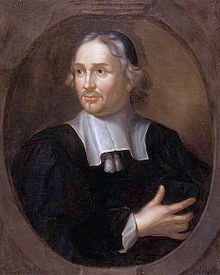Jacobus Golius
Jacobus Golius (also: Jacob van Gool , Jacob Gohl and Iacobo Golio ; * 1596 in The Hague , † September 28, 1667 in Leiden ) was a Dutch orientalist and mathematician .
Life
The son of the actuary at the Dutch feudal court, Theodor Gohl, and his wife Anna Hemelar came from a respected wealthy middle-class family. Golius began studying philosophy, medicine, theology and mathematics at the University of Leiden in 1612 , with his teachers Willebrord Snellius and Franz van Schooten the elder . Barely twenty years old, he retired to his father's country house in order to devote himself entirely to his studies in quiet seclusion. However, he fell ill and his idea of his own studies failed. So in 1618 he went back to the Leiden University to learn Arabic and other Eastern languages. His formative teacher at that time was Thomas Erpenius .
After completing his studies, he stayed in France for some time, teaching Greek in La Rochelle . In 1622 he accompanied the Dutch ambassador to the court of the Sultan of Morocco . Here he completed oriental studies. He made himself familiar with the Arabic language, studied its scripts, tried to write a history of the empire of Fez and Morocco. He brought the translation of the old documents and other documents back to his homeland. After his return, Golius succeeded Erpenius on May 12, 1625 as professor of oriental languages. But since he wanted to continue his studies, he made a trip to Aleppo in Syria, to Arabia and to Constantinople in Turkey from 1626 to 1629 , where he frequented the libraries there intensively.
On his return to Leiden, he also became Professor of Mathematics in 1629, succeeding Snellius. In that activity he achieved the reputation of the most important orientalist of his time. In addition to the rectorate of the Leiden Alma Mater, he was also given various other academic honors. Golius, who had also dealt with the Persian and Chinese languages, translated the New Testament into Modern Greek and the Heidelberg Catechism , as well as the Dutch creeds and liturgical writings, into the Arabic language. His main work is the Lexicon Arabico-Latinum , which has become the standard work of oriental studies across generations. In addition, Golius was in contact with the great scholars of his time such as René Descartes , whose suggestions he incorporated into his teaching program. But his students, such as Andreas Sennert , also carried his work across the borders of Europe. In this way, he had also influenced the work of Johann Wolfgang von Goethe and Johann Jacob Reiske .
He was an early collector of mathematical and astronomical Arabic manuscripts in Leiden.
Works
- Lexicon Arabico-Latinum. Typis Bonaventuræ & Abrahami Elseviriorum, Leiden 1653 (Johann Wolfgang von Goethe mentions this dictionary in his diary on February 12, 1819. Georg Wilhelm Friedrich Freytag published it as a four-volume work: Lexicon arabico-latinum , Halle 1830–1837.)
- Proverbia quaedam Alis, imperatoris Muslemici, et Carmen Tograipoetae doctissimi, necnon dissertatio quaedam Aben Synae. 1629.
- Ahmedis Arabsiadae vitae et rerum gestarum Timuri, gui vulgo Tamer, lanes dicitur, historia. 1636.
- Publication of a new edition with essential additions to the Grammatica Arabica by Erpenius.
- Joan Blaeu , Martino Martinio, Jacobus Golius: Novvs Atlas, Das ist, Weltbeschreibung ... In which Asia, and Sina. Blaeu [Amsterdam] 1655. (See also: Atlas Maior )
- Dictionarium Persico-Latinum (published by Edmund Castell in his Lexicon heptaglotton , 1669).
- Muhammedis, filii Ketiri Ferganensis, qui vulgo Alfraganus dicitur, elementa astronomica Arabice et Latine. 1669. Available online
literature
- E. Savage-Smith, Colin Wakefield: Jacobus Golius and celestial cartography . In: WD Hackmann and AJ Turner (Eds.): Learning, Language and Invention: Essays. Presented to Francis Maddison. Aldershot, Variorum, 1994, pp. 238-260.
- Golius, Jacobus. In: Johann Heinrich Zedler : Large complete universal lexicon of all sciences and arts . Volume 11, Leipzig 1735, column 892 f.
- Jacob Cornelis van Slee : Golius, Jakob . In: Allgemeine Deutsche Biographie (ADB). Volume 9, Duncker & Humblot, Leipzig 1879, p. 343.
- Johann Samuelersch and Johann Gottfried Gruber : General Encyclopedia of Sciences and Arts . Hermann Brockhaus Verlag, Leipzig 1861, 1st Sect., Part 73, p. 341 ( online )
Web links
| personal data | |
|---|---|
| SURNAME | Golius, Jacobus |
| ALTERNATIVE NAMES | Gool, Jacob van; Gohl, Jacob; Golio, Iacobo |
| BRIEF DESCRIPTION | Dutch orientalist and mathematician |
| DATE OF BIRTH | 1596 |
| PLACE OF BIRTH | The hague |
| DATE OF DEATH | September 28, 1667 |
| Place of death | Suffer |
